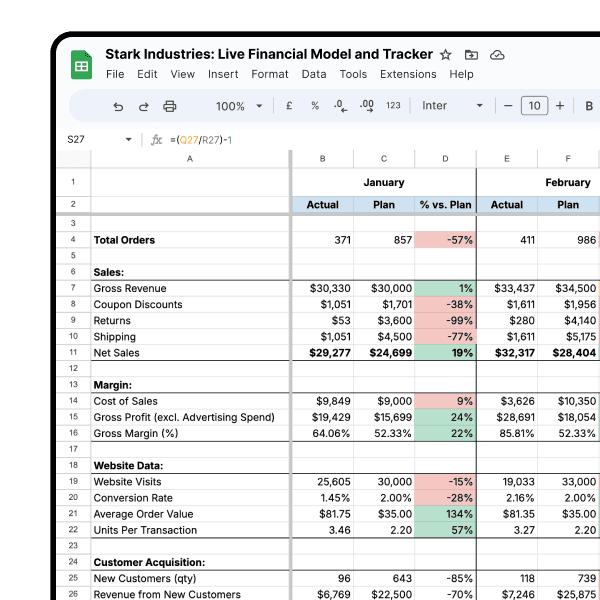Growth Strategies
13.01.2023
TLDR
E-commerce businesses should avoid common mistakes when planning for the year such as failing to set clear goals, neglecting customer experience, and overlooking automation. Instead, create specific, measurable, achievable, realistic, and timely goals. Focus on delivering positive customer experiences at every interaction and utilize automation tools like Airboxr and Alloy to streamline tasks. By addressing these challenges, e-commerce merchants can create a successful plan for the year ahead.
Yearly planning is an important part of any business, and e-commerce merchants are no exception. Every direct to consumer business will face some similar challenges; the benefit of that is the ability to learn from others' mistakes. In this blog post, we will discuss three common mistakes merchants make, and steps you can take to overcome them.
Failure to Develop Clear Goals
A common mistake e-commerce merchants make with yearly planning is failing to develop clear goals. Without a set plan, it can be difficult to track progress and measure success. To avoid this mistake, merchants should create specific, measurable, achievable, realistic, and timely goals that they can track.
One way to do this is to develop a roadmap for your business, so that you can track your progress towards your business goals. You can create a timeline view outlining Q1 to Q4 of the year as column headers, with rows indicating the different departments or teams in your organization, including milestones you want to achieve. This will help you keep track of your goals.
In a previous blog post, we talked about three different types of e-commerce businesses and how their business goals may differ. Read the article to find out if your business falls into any one of the three main categories.
Also read: How to plan your growth strategy as a D2C brand in 2023
Lack of Focus on Customer Experience
A customer will encounter multiple touchpoints in the course of making a purchase. For example, they may see an ad for a product on your website, then interact with the product listing on your website itself and notice your free shipping offer with a minimum spend, then browse the site for other items to fill their cart, then go to checkout and get an upsell, then pay and get notified of their delivery information, then receive the parcel from the courier service.
The more touchpoints a customer experiences, the greater potential there is for them to have a negative experience. You want to ensure each touchpoint offers the customer a positive experience, so that you can build their trust in your brand.
One way to do this would be to set up a loyalty programme which keeps track of your customers’ product preferences and shopping habits. With the data collected, you can then follow up with highly personalized offerings so as to delight your customer.
Having customer data also helps you to keep bringing your customers back with rewards, points and VIP tiers, implement wishlists and trigger sale or back in stock emails to boost sales, incentivize customers to leave reviews, and much more. In case your customer needs help, having a unified helpdesk with centralized information will also help your customer service team provide stellar service when responding to your customer’s issue.
Some apps you can use to increase customer engagement and improve your customer experience are:
Growave - an all-in-one Shopify marketing app with powerful tools for reviews, wishlists, loyalty programs, gift cards, referrals, rewards, and user generated content.
Gorgias - a helpdesk which unifies all customer interactions with order information, reduces checkout friction, and enables sales within support.
Improve your DTC game. Sign up for weekly tips.
Not Utilizing Automation
Finally, e-commerce merchants should not overlook the importance of automation. Automation helps to cut down “busywork” and reduce the time and effort needed for mundane tasks, allowing merchants to focus on more important tasks.
In any e-commerce business, the most time-consuming repetitive work lies in data reporting. Businesses spend hours and days pulling together reports for their monthly and quarterly reviews. Often, they waste precious time asking for reports from different departments and teams, which they have to clean and format into a unified report at the end of the day.
One way to cut down on repetitive busywork is to integrate your website and marketing platforms with an app that automates data reporting, so that you don’t waste hours cleaning and collating data repetitively. You can also look at automating other areas of your workflow such as sending information to the right department based on certain customer behaviour.
Some apps to help you automate your reporting and workflow are:
Airboxr - automates your mundane data work while you focus on the business. It provides predesigned analysis on your store-, marketing-, and operational- data sources.
Alloy - a no code workflow builder to connect your apps. It allows you to add logical branches based on data or events from your store or other apps.
Yearly planning is an important part of any e-commerce business. However, merchants must be aware of the common mistakes they can make and how to avoid them. By developing clear goals, focusing on customer experience, and utilizing automation, merchants can create a successful plan for the year ahead.


